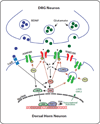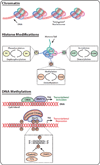Cellular, molecular, and epigenetic mechanisms in non-associative conditioning: implications for pain and memory
- PMID: 23796633
- PMCID: PMC3769437
- DOI: 10.1016/j.nlm.2013.06.008
Cellular, molecular, and epigenetic mechanisms in non-associative conditioning: implications for pain and memory
Abstract
Sensitization is a form of non-associative conditioning in which amplification of behavioral responses can occur following presentation of an aversive or noxious stimulus. Understanding the cellular and molecular underpinnings of sensitization has been an overarching theme spanning the field of learning and memory as well as that of pain research. In this review we examine how sensitization, both in the context of learning as well as pain processing, shares evolutionarily conserved behavioral, cellular/synaptic, and epigenetic mechanisms across phyla. First, we characterize the behavioral phenomenon of sensitization both in invertebrates and vertebrates. Particular emphasis is placed on long-term sensitization (LTS) of withdrawal reflexes in Aplysia following aversive stimulation or injury, although additional invertebrate models are also covered. In the context of vertebrates, sensitization of mammalian hyperarousal in a model of post-traumatic stress disorder (PTSD), as well as mammalian models of inflammatory and neuropathic pain is characterized. Second, we investigate the cellular and synaptic mechanisms underlying these behaviors. We focus our discussion on serotonin-mediated long-term facilitation (LTF) and axotomy-mediated long-term hyperexcitability (LTH) in reduced Aplysia systems, as well as mammalian spinal plasticity mechanisms of central sensitization. Third, we explore recent evidence implicating epigenetic mechanisms in learning- and pain-related sensitization. This review illustrates the fundamental and functional overlay of the learning and memory field with the pain field which argues for homologous persistent plasticity mechanisms in response to sensitizing stimuli or injury across phyla.
Keywords: 4EBP; 5-HT; 5-aza; 5-azacytidine; Aplysia; BDNF; C/EBP; CAMKII; CBS; CCAAT enhancer binding protein; CCI; CFA; COX-2; CPB; CPEB; CRE; CREB; CREB-binding protein; Ca(2+); Central sensitization; DHPG; DNA methyltransferase; DNA methyltransferase inhibitor; DNMT; DNMTi; DRG; EIF4E; EIF4E binding protein; ERK; Epigenetic; FCS; FK 506 binding protein; FKBP5; FMRFa; HAT; HDAC; HDACi; Histone; IL-6; IP3; ITF; LE; LG; LTD; LTF; LTH; LTP; LTS; Left E cluster; MAPK; MeCP2; Methylation; NF-κB; NO; NRM; NRSE; NRSF; PARP; PGE2; PKA; PKC; PKG; PKM; PSNL; PTM; PTSD; Pi-RNAs; Piwi-interacting RNAs; Pre-Met-ARg-Phe-NH(2); S-adenosyl-methionine; S6 kinase; S6K; SAHA; SAM; SGK1; SGWR; SNI; SNL; STF; SULT1A1; Sensitization; TOR; TSA; TrkB; UCH; VC; ZIP; brain derived neurotrophic factor; cAMP; cAMP response element; cAMP response element binding protein; cAMP-dependent protein kinase; cGMP; calcium; calmodulin-dependent protein kinase II; chronic constriction injury; complete Freund’s adjuvant; cyclic adenosine monophosphate; cyclic guanosine monophosphate; cyclooxygenase-2; cystathionine-β-synthase; cytoplasmic polyadenylation element binding protein; dihydroxyphenylglycine; dorsal root ganglion; eEF2; eukaryotic elongation factor 2; eukaryotic translation initiation factor 4E; extracellular receptor kinase; fast conducting system; histone acetyltransferase; histone acetyltransferase E1A binding protein p300; histone deacetylase; histone deacetylase inhibitor; inositol 1,4,5-trisphosphate; interleukin 6; intermediate-term facilitation; lateral giant neuron; long-term depression; long-term facilitation; long-term hyperexcitability; long-term potentiation; long-term sensitization; methyl-CpG-binding protein 2; mitogen activated protein kinase; neuron-restrictive silence factor; neuron-restrictive silencer element; nitric oxide; nuclear factor kappa-light-chain-enhancer of activated B cells; nucleus raphe magnus; p300; partial sciatic nerve ligation; poly-(ADP-ribose) polymerase; post-translational modifications; post-traumatic stress disorder; prostaglandin E2; protein kinase C; protein kinase G; protein kinase M; serotonin; serum- and glucocorticoid-inducible kinase; short-term facilitation; siphon-gill withdrawal reflex; spared nerve injury; spinal nerve ligation; suberoylanilide hydroxamic acid; sulfotransferase family 1A, phenol-preferring, member 1; target of rapamycin; trichostatin A; tyrosine kinase receptor B; ubiquitin C-terminal hydrolase; ventrocaudal clusters; zeta inhibitory peptide.
Copyright © 2013 Elsevier Inc. All rights reserved.
Figures



Similar articles
-
BDNF-induced local protein synthesis and synaptic plasticity.Neuropharmacology. 2014 Jan;76 Pt C:639-56. doi: 10.1016/j.neuropharm.2013.04.005. Epub 2013 Apr 16. Neuropharmacology. 2014. PMID: 23602987 Review.
-
BDNF mechanisms in late LTP formation: A synthesis and breakdown.Neuropharmacology. 2014 Jan;76 Pt C:664-76. doi: 10.1016/j.neuropharm.2013.06.024. Epub 2013 Jul 2. Neuropharmacology. 2014. PMID: 23831365 Review.
-
Shaping synaptic plasticity: the role of activity-mediated epigenetic regulation on gene transcription.Int J Dev Neurosci. 2013 Oct;31(6):359-69. doi: 10.1016/j.ijdevneu.2013.04.003. Epub 2013 May 9. Int J Dev Neurosci. 2013. PMID: 23665156 Review.
-
Protein kinase M maintains long-term sensitization and long-term facilitation in aplysia.J Neurosci. 2011 Apr 27;31(17):6421-31. doi: 10.1523/JNEUROSCI.4744-10.2011. J Neurosci. 2011. PMID: 21525283 Free PMC article.
-
Epigenetic regulation in human melanoma: past and future.Epigenetics. 2015;10(2):103-21. doi: 10.1080/15592294.2014.1003746. Epigenetics. 2015. PMID: 25587943 Free PMC article. Review.
Cited by
-
Chronic pain as an emergent property of a complex system and the potential roles of psychedelic therapies.Front Pain Res (Lausanne). 2024 Apr 19;5:1346053. doi: 10.3389/fpain.2024.1346053. eCollection 2024. Front Pain Res (Lausanne). 2024. PMID: 38706873 Free PMC article.
-
Pulsed radiofrequency attenuates diabetic neuropathic pain and suppresses formalin-evoked spinal glutamate release in rats.Int J Med Sci. 2016 Dec 8;13(12):984-991. doi: 10.7150/ijms.16072. eCollection 2016. Int J Med Sci. 2016. PMID: 27994505 Free PMC article.
-
Differential Gene Expression Profile in the Rat Caudal Vestibular Nucleus is Associated with Individual Differences in Motion Sickness Susceptibility.PLoS One. 2015 Apr 24;10(4):e0124203. doi: 10.1371/journal.pone.0124203. eCollection 2015. PLoS One. 2015. PMID: 25910039 Free PMC article.
-
Dynamic DNA methylation regulates neuronal intrinsic membrane excitability.Sci Signal. 2016 Aug 23;9(442):ra83. doi: 10.1126/scisignal.aaf5642. Sci Signal. 2016. PMID: 27555660 Free PMC article.
-
Genetic and epigenetic mechanisms influencing acute to chronic postsurgical pain transitions in pediatrics: Preclinical to clinical evidence.Can J Pain. 2022 May 10;6(2):85-107. doi: 10.1080/24740527.2021.2021799. eCollection 2022. Can J Pain. 2022. PMID: 35572362 Free PMC article. Review.
References
-
- Abbott FV, Franklin KB, Westbrook RF. The formalin test: scoring properties of the first and second phases of the pain response in rats. Pain. 1995;60:91–102. - PubMed
-
- Agrawal RP, Goswami J, Jain S, Kochar DK. Management of diabetic neuropathy by sodium valproate and glyceryl trinitrate spray: a prospective double-blind randomized placebo-controlled study. Diabetes Res Clin Pract. 2009;83:371–378. - PubMed
-
- Alberini CM, Ghirardi M, Metz R, Kandel ER. C/EBP is an immediate-early gene required for the consolidation of long-term facilitation in Aplysia. Cell. 1994;76:1099–1114. - PubMed
-
- Andrews N, Legg E, Lisak D, Issop Y, Richardson D, Harper S, Huang W, Burgess G, Machin I, Rice AS. Spontaneous burrowing behaviour in the rat is reduced by peripheral nerve injury or inflammation associated pain. Eur J Pain. 2011 - PubMed
-
- Antonsen BL, Edwards DH. Differential dye coupling reveals lateral giant escape circuit in crayfish. J Comp Neurol. 2003;466:1–13. - PubMed
Publication types
MeSH terms
Grants and funding
LinkOut - more resources
Full Text Sources
Other Literature Sources
Medical
Research Materials
Miscellaneous

